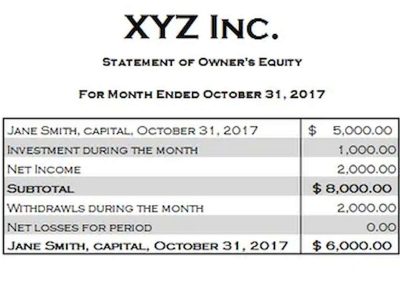However, we highly recommend that you do use the same rules for both purposes, to avoid complicating your life with two sets of financial records. Accounting automation streamlines data collection, reconciliation, adjustments and report generation, significantly reducing book closing time from weeks to days. As you sort out any discrepancies, you’ll document any changes by adjusting journal entries. They offer an overview of a business’s financial position at the end of the applicable accounting period, whether that’s the previous month or year. To ensure accuracy, it’s important to follow the correct format you can refer to our detailed guide Financial Statement Format to help you with this process. One of the major purposes for closing your books at the end of each accounting period is to allow you to prepare financial statements that give you a picture of your business’s financial status. The financial statements prepared for most small businesses are a balance sheet and an income statement. General ledger reports detail individual transactions, offering a granular view of financial activity. Financial statements are then prepared, including the income statement, balance sheet, and cash flow statement. These reports QuickBooks provide a snapshot of the company’s financial health for decision-making, investor reporting, and regulatory compliance. Your startup must develop a step-by-step process and accompanying checklist to ensure your books are closed properly every month. Tackling steps like reviewing preliminary statements, reconciling accounts, and adjusting journal entries will help you get your data straight. We call those temporary accounts, and when we start our new book, we just start accumulating those amounts from zero. However, there is still a closing process that prevents the accountants and bookkeepers from accidentally posting entries to the the closing process is sometimes referred to as closing the books. prior period. The closing process means any books and records that produced the official financial statements are “closed” to any further entries that would cause them to no longer match the published financials. The post closing trial balance reveals the balance of accounts after the closing process, and consists of balance sheet accounts only. If it’s not, the book cannot be closed, and your accountant or bookkeeper will try to figure out why there’s a discrepancy. By closing the books after a given period, companies get a snapshot of a moment in time. When you close the books, it’s much easier to accurately compare performance over certain periods and perform accounting actions like remitting taxes. To streamline your process for closing the books, consider a continuous close or real-time bookkeeping process. A real-time, continuous close means that you reconcile accounts on an ongoing, daily basis. The information is more accurate, and you always have a financial snapshot at the ready. The ending balance for these accounts will be the same as the beginning balance for the next period. These temporary or “nominal” accounts are zeroed out and reset when closing entries are added https://www.bookstime.com/articles/payment-recovery to an accounting system so they don’t affect the next accounting period. It’s easier to make adjustments to journal entries when you use accounting software with connections to expert bookkeepers and tax prep services. Post the account totals from your cash payments and your sales and cash receipts journal to the appropriate general ledger account to close the books. Cash payments (“cash disbursements”) include any payments made by cash, check, or electronic fund transfer. The records are used to generate reports that tell an owner how much money flows in and out of their business. Most small companies close their books monthly, though some only do so at year’s end. For example, you could choose all entries in 2025, or it could be for the month of January 2025 only. It is a clear indicator of the company’s profitability and a critical figure for stakeholders. A positive net income implies profitability, whereas a negative figure indicates a loss. This final figure is essential for evaluating the financial health of the business and informing future strategies.Introduction to Closing the Books Financial Accounting

Profit and Loss Report

best accounting software for startups in 2025


Accounts Receivable Solutions

What Does It Mean to Close the Books?

Close and
What are the key tasks for an accountant in the year-end book closing process?
https://allmy.bio/totoagung2-slot
https://lit.link/en/qdal88link
https://news-business.co.uk/slot-gacor-4d/
https://instabio.cc/qdal88-slot
https://heylink.me/link-alternatif-situs-slot-gacor-online-amintoto/
https://linkby.tw/daftar_restoslot4d
https://heylink.me/qdal88/
https://heylink.me/Slot-Gacor-Terbaru/
https://heylink.me/situs-slot-gacor4d-resmi-mudah-menang/
https://jemi.so/amintoto-situs-slot-online-terpercaya
https://allmy.bio/IDN-Slot-online-amintoto
https://jemi.so/restoslot4dgacor
https://new.c.mi.com/th/post/116758
https://heylink.me/daftar-slot-online-gacor-akun-vip-qdal88/
https://heylink.me/slotgacor4d-situs-slot-online-gampang-menang-resmi-pay4d/
https://lit.link/en/totoagung2slot
https://linkby.tw/qdal88.slot
https://meelink.bio/slot-gacor-maxwin
slot idn
https://heylink.me/bocoran-slot-gacor-pagi-siang-malam-hari-ini-amintoto/
slot gacor 4d
https://naturalhistorymag.com/htmlsite/slot88-gacor/
https://ffm.bio/totoagung-slot
https://heylink.me/slot-demo-pragmatic-qdal88-gratis-tanpa-deposit/
https://mssg.me/totoagung2_slot
https://heylink.me/Slot_Gacor_Hari_Ini/
https://idolink.com/slotgacor4dofficial
https://linkr.bio/restoslot4d-login
https://heylink.me/link-slot-online-gacor-terpercaya-totoagung/
https://heylink.me/bocoran-slot-gacor-hari-ini-situs-judi-online-restoslot4d/
https://new.c.mi.com/th/post/114045
https://linkby.tw/amintoto-link-alternatif
https://naturalhistorymag.com/htmlsite/bo-slot-gacor/
https://heylink.me/Slot-Gacor-2023/
slot online gacor
https://naturalhistorymag.com/content/slot-gacor/
https://mssg.me/qdal88-situs-judi-slot-paling-gacor-hari-ini
https://s.id/totoagung-slot
https://linklist.bio/daftar-slot-4d
https://heylink.me/Slot.Gacor/
https://heylink.me/SlotGacorMaxwin/
https://idolink.com/totoagungslot
https://heylink.me/totoagung-situs-slot-online-resmi-pusat-pragmatic-play/
https://lit.link/en/amintotoslotonline
https://linklist.bio/qdal88-slot
https://lynk.id/qdal88_slot_pulsa
slot pulsa
https://allmy.bio/qdal88-slot
https://heylink.me/bocoran-situs-slot-gacor-gampang-menang-cantiktoto/
https://replit.com/@Resto4d
https://heylink.me/situs-slotgacor-4d-gampang-menang-maxwin/
https://heylink.me/totoagung-situs-slot-online-resmi/
https://heylink.me/totoagung_situs_deposit_pulsa/
https://raizeducacao.com.br/freebet-slot/
https://solo.to/totoagung-slot
https://instabio.cc/totoagung2-slot
https://linkby.tw/slotgacor4d.official
https://heylink.me/totoagung2-situs-slot-online-resmi-gacor-terpercaya-menang/
https://jemi.so/cantiktotositusjudislotonlineterpercayaslotgacorpragmaticplayterbaikdiindonesia
https://replit.com/@qdal88link
https://idolink.com/slothoki
https://lynk.id/amintotoofficial
https://heylink.me/totoagung2-situs-judi-slot-online-gacor-indonesia/
https://instabio.cc/totoagung-slot
https://heylink.me/link-alternatif-resmi-restoslot4d-terbaik-gampang-menang
https://idolink.com/cantiktotoslot
https://heylink.me/link-alternatif-slot-online-gacor-cantiktoto/
https://solo.to/amintoto_official
https://solo.to/resto-slot-4d
https://mssg.me/cantiktoto_slot
https://instabio.cc/Slotgacor4DOfficial
gacor4d
slotgacor4d
https://agungsport.com/
https://heylink.me/cantiktoto-situs-slot-online-terpercaya-gacor-lisensi-resmi/
https://heylink.me/agen-slot-pay4d/
https://allmy.bio/Slotgacor4dOfficial
https://skillscanada.bc.ca/idn-slot/
https://heylink.me/restoslot4d-situs-pay4d-resmi-paling-gacor-indonesia/
https://ffm.bio/amintoto_official
https://heylink.me/amintoto-situs-slot-online-terpercaya-gampang-menang/
https://instabio.cc/link-daftar-amintoto
https://ffm.bio/cantiktoto_slot
https://heylink.me/link-alternatif-slot-pay4d/
https://heylink.me/cantiktoto-link-slot-online-gacor-terpercaya-resmi-idnplay/
https://heylink.me/situs-slot-demo-gratis-totoagung2/
https://ffm.bio/daftar-restoslot4d
slot gacor4d
https://solo.to/slotgacor4dofficial
slot gacor maxwin
https://naturalhistorymag.com/content/spaceman-pragmatic/
https://linklist.bio/amintoto_link_daftar
https://s.id/daftar-restoslot4d
spaceman pragmatic
https://idolink.com/qdal88slot
https://allmy.bio/cantiktoto-slot
https://replit.com/@cantiktotogacor
https://solo.to/totoagung2_slot
https://lynk.id/slotgacor4dofficial
https://linktr.ee/totoagung2
https://heylink.me/Slot-Gacor-2022/
https://s.id/Slotgacor4DOfficial
https://heylink.me/totoagung-situs-slot-online-gacor-terbaik-terpercaya/
https://heylink.me/daftar-slot-gacor-vip-khusus-situs-totoagung2/
https://lit.link/slotgacor4dnew
https://new.c.mi.com/th/post/113199
https://ffm.bio/totoagung2_slot
https://ffm.bio/qdal88_slot4d
https://linklist.bio/Slotgacor4DOfficial
https://lynk.id/cantiktoto
https://www.soulrichwoman.com/slotgacor4d/
https://mssg.me/slotgacor4dofficial
https://instabio.cc/daftar-slot-4d
https://wlo.link/@cantiktoto_slot
https://linkby.tw/totoagung2slot
slot deposit pulsa
https://heylink.me/cantiktoto-bandar-slot-online-gacor-resmi-idnplay/
https://idolink.com/totoagung2slot
https://heylink.me/agen-slot-pay4d/
https://wlo.link/@restoslot4d_gacor
https://heylink.me/amintoto-daftar-situs-slot-online-gacor-indonesia/
https://heylink.me/SlotGacor4D/
https://mssg.me/amintoto-slot-online
https://instabio.cc/cantiktoto-link
https://lynk.id/totoagung2_slot
https://ffm.bio/slotgacor4dofficial
https://replit.com/@totoagung2slot
https://heylink.me/link-alternatif-slot-freebet-qdal88/
https://heylink.me/qdal88-situs-slot-gacor-online-freebet-tanpa-deposit/
https://heylink.me/situs-slot-gacor-4d-gampang-menang/
https://linkby.tw/cantiktotolink
https://wlo.link/@totoagung_slot
https://linklist.bio/totoagung2_slot
https://akangzeyus.com/
https://replit.com/@totoagungslot
https://heylink.me/link-alternatif-slot-pay4d/
https://lynk.id/totoagung_slot
https://linkr.bio/qdal88-slot4d
https://motivasiagung.com/
https://heylink.me/slot-gacor-online-rtp-tertinggi-situs-judi-amintoto/
https://mssg.me/slot-hoki-restoslot4d
https://linklist.bio/totoagung-slot
https://heylink.me/cantiktoto/
https://solo.to/qdal88-slot
https://heylink.me/agen-slot-gacor-terkuat-totoagung-gampang-menang/
https://heylink.me/restoslot4d-rtp-live-slot-gacor-tertinggi-hari-ini/
https://replit.com/@AmintotoDaftar
https://lit.link/en/cantiktotolink
https://allmy.bio/totoagung-slot
https://heylink.me/restoslot4d-daftar-situs-slot-gacor-online-pay4d/
https://produkvvip.com/
https://s.id/amintoto-slot-online
https://heylink.me/link-slot-gacor-totoagung2-pusat-game-terlengkap/
https://s.id/cantiktoto_slot
https://lit.link/en/restoslot4dterpercaya
https://lynk.id/daftar_slot_4d
https://heylink.me/agen-slot-demo-pragmatic-terpercaya-qdal88/
https://linkby.tw/totoagung-slot
https://heylink.me/Slot-Gacor-4D/
https://heylink.me/qdal88.gampang.hoki/
https://www.printersupportpro.us/blog/wp-content/uploads/slot-idn/
https://lynk.id/totoagung_link
https://idolink.com/amintotodaftarslotonline
https://replit.com/@Slotgacor4doff
https://heylink.me/Link_Slot_Gacor/
https://mssg.me/totoagung-situs-slot-online-paling-gacor
freebet slot
idn slot
Popular Posts
Comments are Off
Comments are Off
Comments are Off
Categories
- ! Без рубрики (8)
- 1 (6)
- 1x-bet.sbs (1)
- 1xslot.beregaevo.ru 4-8 (1)
- 2 (1)
- 2708_agc-Platform.Co.Za (1)
- 3 (1)
- 6 (1)
- a16z (1)
- a16z generative ai (1)
- adobe generative ai 2 (1)
- Ai News (1)
- amminex.net 2 (1)
- ancorallZ (1)
- ancorallZ 1000 (1)
- ancorallZ 1250 (1)
- ancorallZ 2000_3 (1)
- ancorallZ 3000 (1)
- anonymous (1)
- aromeconte.ru 500 (1)
- articles (10)
- bahsegel 13004 (1)
- bashpirat.ru 2000 (1)
- Best Online Casino Games for UK Players in 2025 (1)
- bet1 (1)
- bettilt 9346 (1)
- betting (2)
- blog (98)
- Bookkeeping (6)
- Boomerang (1)
- bootstrap-3.rugetting-started.php 900 (1)
- Casino (5)
- Child Custody (9)
- Child Support (21)
- csb-online.ru 500 (1)
- daavdeev.ru 120 (1)
- Divorce (24)
- dogakentkres.com 1 (1)
- efrosini-winery.gr (1)
- Entertainment (1)
- Fairspin 2 (1)
- Fairspin-casino (1)
- Family law (21)
- FinTech (3)
- fortune-gems.com.ph1 (1)
- gambling (5)
- games (5)
- general (4)
- glory-casino-bangladesh.net2 (1)
- gordostnation.ru 50 (1)
- guide (4)
- happy-chicken.ruonas 500 (1)
- info (6)
- IT Vacancies (3)
- IT Образование (3)
- ivpokrov.ru 170 (1)
- Jetton RU (1)
- Jojobet (1)
- juneCH (1)
- kazandiran-slotlar.com 1500 (1)
- kestrelmedtech.com (1)
- kilmezedu.ru 36 (1)
- kimkafka.com 1000 (1)
- Leading online gaming sites in the UK (1)
- lmpdesign.ru 500 (1)
- meteo-news.gr (1)
- misc (2)
- Mostbet (3)
- mvclinic.ru 10 (1)
- NEW (6)
- news (21)
- normel-spb.ru 2500 (1)
- Online casino (24)
- Online gambling (3)
- Pablic (4)
- pages (6)
- perepelinye.ru 500 (1)
- Pin-Up AZ (1)
- Pin-Up indir (1)
- Pin-Up oyunu (1)
- Pin-Up TR (1)
- Pin-Up UZ (1)
- Pin-UP VCH (1)
- Pin-Up yukle (1)
- pinc0.art (1)
- Pinco Giriş (1)
- Pinco türkiye (1)
- PinUp Giriş (1)
- Post (114)
- posts (5)
- Prenuptial Law (3)
- press (2)
- PT (1)
- Public (1)
- r7csn.club (1)
- r7csn.xyz (1)
- reviews (4)
- reyting-luchshih-onlayn-kazino.xyz 1 (1)
- rezume2016.ru 36 (1)
- rostinternet.ru 500 (1)
- rsem.pro (1)
- s (2)
- school-64.ru 4-8 (1)
- sh18.ru (1)
- Slot Gacor (1)
- slots (3)
- smartline93.ru 240 (1)
- Sober living (3)
- Software development (4)
- Spousal Support (9)
- stories (2)
- temyrazgovora.ru 500 (1)
- top-reyting-onlayn-kazino.xyz 2 (1)
- topblognews.ru 500 (1)
- Uncategorized (663)
- updates (3)
- uwe-ochsenknecht.com (1)
- www.betspecial.co.uk 30 (1)
- www.kartaznaniy.ru 10 (1)
- xn--55-6kcyk1d2d.xn--p1ai 50 (1)
- yatirimsiz-deneme-bonusu.com 1000 (1)
- zendesk vs. intercom (1)
- zivotzasite.mk (1)
- Микрокредит (15)

GET IN TOUCH
Please contact us for more information. Our email is monitored seven days a week and we will get back to you shortly.





